|
|
|
Sort Order |
|
|
|
Items / Page
|
|
|
|
|
|
|
| Srl | Item |
| 1 |
ID:
142590
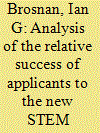

|
|
|
|
|
| Summary/Abstract |
In 2014, the U.S. Office of Personnel Management's Presidential Management Fellowship (PMF) Program initiated a pilot, PMF STEM, to bring recent graduates with advanced degrees in science, technology, engineering, and mathematics (STEM) fields into federal service. The NASA Office of Human Capital was closely engaged, and the pilot was a welcome new avenue for STEM hiring. Here, I ask how the Finalists in this new STEM program fared relative to traditional PMF finalists. I find that the rates at which traditional PMF and PMF STEM Finalists in the Class of 2014 received their first appointment offers were significantly different (p = 0.0315), and PMF STEM Finalists were initially offered appointments at higher rates than the PMF Finalists. However, this advantage disappeared over time, possibly because the remaining PMF STEM Finalists were not a good fit to the available STEM opportunities. When the appointment period for the Class of 2014 closed, 58% of PMF STEM Finalists and 72% of PMF Finalists had received appointment offers. Although a smaller proportion of PMF STEM Finalists received offers in 2014, their offer rate was consistent with the long-term average. I briefly discuss the NASA context for these results.
|
|
|
|
|
|
|
|
|
|
|
|
|
|
|
|
| 2 |
ID:
142586
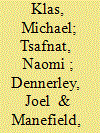

|
|
|
|
|
| Summary/Abstract |
Biotechnological resource extraction methods such as biomining and biogas production could fill a vital niche in currently proposed ways for extracting minerals and producing fuel on asteroids. Well established on Earth, biomining applications on asteroids could significantly increase the output and efficiency of minerals processing. Biogas production, unlike conventional fuel extraction processes, relies on the presence of carbonaceous chondrite on asteroids. Bacteria placed on or within the asteroid would ferment these carbon sources and methanogenic Archaea would produce methane for spacecraft propulsion and industrial applications. Supporting microbial communities in space requires a thorough understanding of the limitations of microbial life, interacting environmental parameters as well as factors such as asteroid structure and nutrient availability. This paper examines engineering and ecological principles required to support an asteroid based microbial community. In addition socioeconomic factors such as current space policy and potential economic prospects are also discussed. Biotechnology is increasingly filling a niche in conventional engineering; with the advent of a new era in space, evolving these technologies is vital to fully developing humanity's space faring capabilities.
|
|
|
|
|
|
|
|
|
|
|
|
|
|
|
|
| 3 |
ID:
142588


|
|
|
|
|
| Summary/Abstract |
To stimulate the development of new technologies is nowadays one of the main goals of public policies in developed and emerging countries. However, certain high-tech sectors are mainly driven by government procurement, increasing the active role of government in investments and research. In this sense, this paper aims to identify, compare and discuss mechanisms used to foster innovation in specific high-tech sectors in which government is the main client. This research analyses the innovation mechanisms in the space industry in an emerging country and a developed country, taking Brazil and The Netherlands as contrasting examples. A case study research was conducted, in which representatives in companies and research centres with space related activities were interviewed, comprising twelve organizations in both countries. Results of the Dutch space industry demonstrated the role of committees involving government, industry and researchers in space technology. These committees discuss which the technological pathways of space industry are, aligning scientific research with companies' needs. In Brazil, the introduction of the Innovation Act in 2004 began to stimulate interaction between university, industry, and government. However, these relationships are mainly informal and incipient. As a conclusion, it could be observed that while in The Netherlands different agents join efforts in order to plan the sector's technological development; in Brazil such relationships are still incipient. This difference could be explained by a modest technological development of Brazilian companies and research institutes, which mainly import products from foreign companies. Learning from the Dutch experience, in order to improve the Brazilian space sector it is necessary to foster S&T activities through joint activities between universities, companies and government.
|
|
|
|
|
|
|
|
|
|
|
|
|
|
|
|
| 4 |
ID:
142587


|
|
|
|
|
| Summary/Abstract |
In 2013, NASA completed its Commercial Orbital Transportation Services (COTS) program. Initiated in 2005, COTS developed a privately operated cargo transport system for the International Space Station (ISS). In doing so, it met an urgent NASA need to replace a vital space shuttle function and heralded the prospect of crew transportation. It also fostered more competition in the aerospace industry aimed at lowering costs for space access. Finally, it gave hope that low-earth orbit might someday become more the preserve of the industrial sector, so that NASA could concentrate its constrained government resources on deep-space exploration.
This essay analyzes the case of COTS as a policy innovation – how it was born, led, and the forces that helped and hindered it during its eight-year journey from concept to closure. It indicates factors critical to its success.
|
|
|
|
|
|
|
|
|
|
|
|
|
|
|
|
| 5 |
ID:
142583
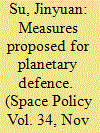

|
|
|
|
|
| Summary/Abstract |
Whereas the Earth is showered by extraterrestrial matters on a constant basis, most of them cannot survive the very high heat produced in their entry into the atmosphere to make a terrestrial impact. Impacts that are capable of inflicting terrestrial casualties and damages are even rarer. However, their consequences can be high, and even so nowadays with the change of human settlement patterns on the Earth. With the development of space science and technology, human beings are now capable of predicting possible impacts with some accuracy, and even minimizing the chance of actual collision. For the later purpose, many proposals have been put forward, which either employ weapons readily found on the Earth, or envisage newly developed technologies that could nevertheless be used for military purposes. This short note applies existent international law to these measures, and attempts to shed some light on their implications for ongoing discussions of space arms control.
|
|
|
|
|
|
|
|
|
|
|
|
|
|
|
|
| 6 |
ID:
142585
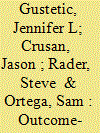

|
|
|
|
|
| Summary/Abstract |
In an increasingly connected and networked world, the National Aeronautics and Space Administration (NASA) recognizes the value of the public as a strategic partner in addressing some of our most pressing challenges. The agency is working to more effectively harness the expertise, ingenuity, and creativity of individual members of the public by enabling, accelerating, and scaling the use of open innovation approaches including prizes, challenges, and crowdsourcing. As NASA's use of open innovation tools to solve a variety of types of problems and advance of number of outcomes continues to grow, challenge design is also becoming more sophisticated as our expertise and capacity (personnel, platforms, and partners) grows and develops. NASA has recently pivoted from talking about the benefits of challenge-driven approaches, to the outcomes these types of activities yield. Challenge design should be informed by desired outcomes that align with NASA's mission. This paper provides several case studies of NASA open innovation activities and maps the outcomes of those activities to a successful set of outcomes that challenges can help drive alongside traditional tools such as contracts, grants and partnerships.
|
|
|
|
|
|
|
|
|
|
|
|
|
|
|
|
| 7 |
ID:
142589
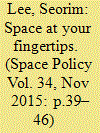

|
|
|
|
|
| Summary/Abstract |
National space programs require the continuous interest and support of the public and government. Surveys and polls are the most commonly used method to monitor the public opinion regarding space activities. Such methods however can only measure the public view of a sample population of people at a specific moment in time. This paper examines the use of internet search trends to monitor and assess the public's changing interest in space activities. By analyzing the varying trends in online demand for information related to space activities, the impact of the government space programs as well as the factors that influence the public's interest are examined. Internet trend data has the potential to become a new metric to assess the relative performance of space policy initiatives, especially in terms of acquiring and managing the interest of the public. The continued interest and support of the public is vital for long term space programs, such as the lunar exploration program, to withstand the changing political environment of multiple administrations.
|
|
|
|
|
|
|
|
|
|
|
|
|
|
|
|
| 8 |
ID:
142584
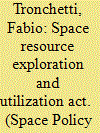

|
|
|
|
|
| Summary/Abstract |
On May 21, 2015, the US House of Representatives passed a revised version of the ASTEROIDS Act, now labeled the Space Resource Exploration ad Utilization Act. If endorsed also by the US Senate the Act may be formally enacted into law by the President of the United States. In the light of this important development it seems appropriate to analyze the content and the legal and political implications of the Space Resource Exploration and Utilization Act.
|
|
|
|
|
|
|
|
|
|
|
|
|
|
|
|
|
|
|
|
|